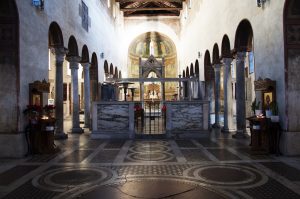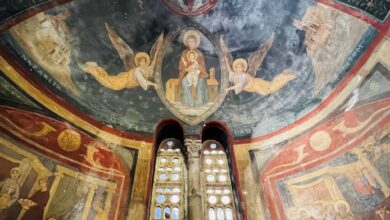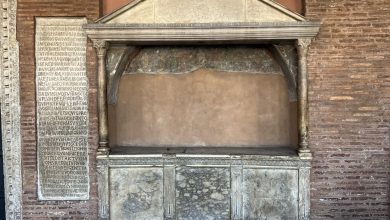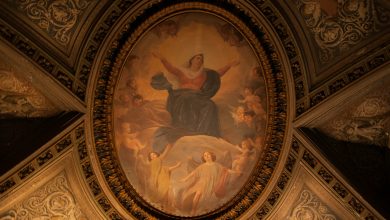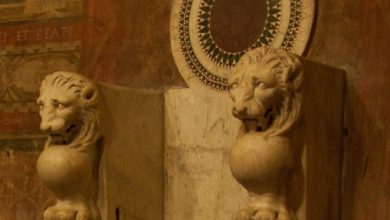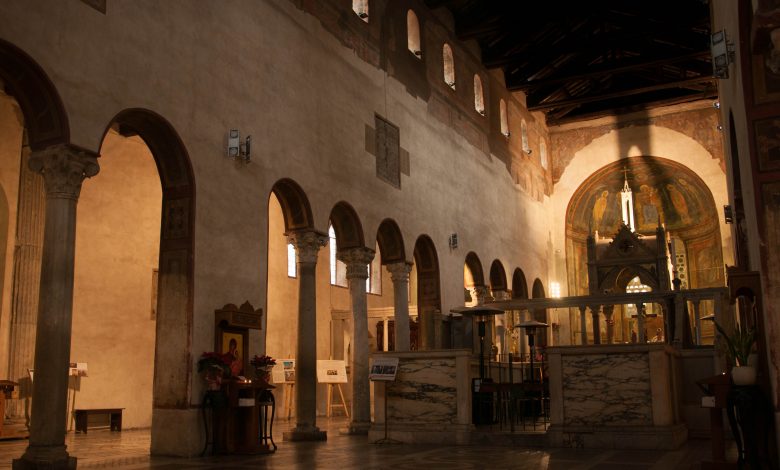
LA SCHOLA CANTORUM
La schola cantorum si trova al centro dell’aula, rialzata di un gradino. Essa è decorata con un meraviglioso pavimento, dal disegno finissimo, opera del Cosma. Subito a lato della piccola gradinata, che si apre a destra della «schola», si innalza il «cero pasquale». Esso poggia su un supporto, sul quale si trova un leone (opera del XIII sec.) che regge la base della colonnina tortile (dono del Crescimbeni, 1716). Superata la «schola» incontriamo il «ciborio di Deodatus»: il baldacchino, in stile gotico fiorentino, opera di Deodato Cosma, terzo figlio di Cosma il giovane (1294).
THE SCHOLA CANTORUM
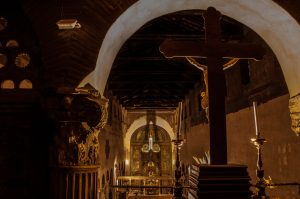
The « Schola cantorum » stands a step higher in the middle of the central nave. It is decorated with a Magnificat floor, the very refined design of which is by Cosma. Beside the small flight of steps which is on the right of the «schola », stands the «Paschal candle ». It leans on a support on which there is a lion (a work of the 13th century) which supports the base of the tortile column (a gift of Crescimbeni, 1716). Beyond the «schola » there is the «ciborium of Deodatus »: the canopy, in Gothic Florentine style, is a work by Deodato Cosma, the third son of the younger Cosma (1294).
La SCHOLA CANTORUM
La « schola cantorum » se trouve au centre du hall, surélevée d’un gradin. Elle est décorée d’un pavement merveilleux, d’un dessin très fin, œuvre de Cosma. Immédiatement à côté des petits gradins, à droite de la « schola » s’élève le cierge de Pâques. Il est soutenu par un support sur lequel se trouve un lion (œuvre du XIIIème siècle) qui tient le pied de la petite colonne tortoillée (don de Crescimbeni, 1716). Passé la « schola », nous rencontrons «l’ostensoir de Déodat»: le baldaquin, en style gothique florentin, œuvre de Déodat Cosma, troisième fils de Cosma le Jeune (1294).
DIE SCHOLA CANTORUM
Die « Schola Cantorum » befindet sich in der Mitte der Aula, um eine Stufe erhöht. Sie ist mit einem herrlichen Fußboden verziert, der eine sehr feine Zeichnung, eine Arbeit des Cosma, aufweist. Direkt neben der kleinen Stufentreppe, die rechts der « Schola » hinauffährt, erhebt sich die « Osterkerze». Diese wird von einem Träger getragen, auf dem sich ein Löwe befindet (ein Werk aus dem XII. Jh.), der den Fuß der kleinen gewundenen Kolonne festhält (ein Geschenk des Crescimbeni, 1716). Hinter der «Schola» begegnen wir der « Monstranz des Deodatus»: dem Baldachin, im Florentiner goethischen Stil, erk des Deodatus Cosma, dritter Sohn des Cosma der Jüngere (1294).
LA SCHOLA CANTORUM
